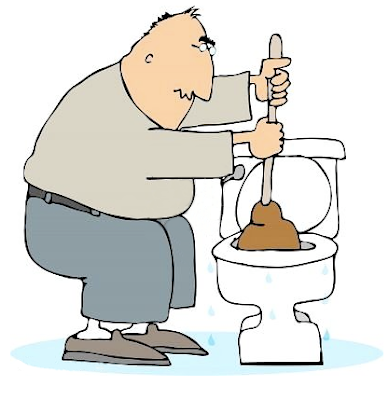
Having a few basic tools on hand at home really helps in resolving simple problems yourself. One of the most basic and helpful tools has got to be the toilet plunger. Clogs may not happen often, but when they do they can be really inconvenient. Murphy's Law has them happening after hours or (better yet) on a holiday when you have a house full of people. Not always the easiest times to call on a plumber to help you out.
 Fortunately, an inexpensive plunger can clear most simple clogs. Do yourself a big favor and keep one on hand. Choose either the basic type (the red one) or the type with an extended cup (the black one) for a better seal and easier plunge.
Fortunately, an inexpensive plunger can clear most simple clogs. Do yourself a big favor and keep one on hand. Choose either the basic type (the red one) or the type with an extended cup (the black one) for a better seal and easier plunge.
And then, if or when that fateful time comes, when your toilet refuses to drain, follow these simple steps and we think you'll find success!
1
First, take a quick inventory of small items that might have inadvertently fallen into the bowl. A toy, lip stick or other toiletry (and we've see weirder than that) could have dropped into the toilet and gone partially down the drain line or even be lodged in the toilet's trap. If either is the case, you might need to call in a plumber. But if nothing seems to be missing, you may just be dealing with a simple clog that can be cleared with a plunger.
2
This from the Just In Case Dept: put some old towels or rags on the floor around the toilet just in case of spills, drips or splashes. You never know but best to be prepared.
3
The level of the water may very well have risen perilously close to the top of the bowl. To avoid a real mess, scoop water out of the toilet bowl into a bucket. Leave enough water in the toilet bowl to cover the plunger
4 Insert the plunger into the toilet, making sure the rubber cup is fully seated over the drain opening and covered with water.
5 Push the plunger handle down firmly. Increase pressure on the clog by pushing and releasing the plunger 10 to 15 times. Avoid wild or sloppy action or you could damage the toilet. If the clog isn't too tight or too far along the drain line, the increased water pressure caused by the plunger will probably clear the obstruction.
6When you think the clog has move, be brave and go ahead and flush the toilet. As a precaution, have the toilet tank lid off and be ready to stop the water flow by raising the ball in the toilet tank.
7
If the clog stubbornly resists your most earnest plunging, a toilet auger and/or a call to the plumber may be needed. Lost objects almost certainly will require an auger to free up - and it's quite possible the toilet will need to be removed and turned upside down to retrieve any objects caught in the toilet itself.
We've also heard that a squirt of dish soap followed by a dose of warm water has been known to help free up clogs, but we haven't tried it ourselves so don't quote us on that.
If you do have any difficulties, you know you can call us. We're here to help.
Boden Plumbing
Sonoma, Napa and Petaluma - 707 996 8683












